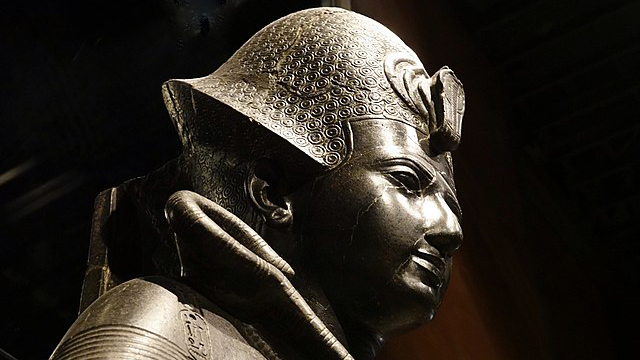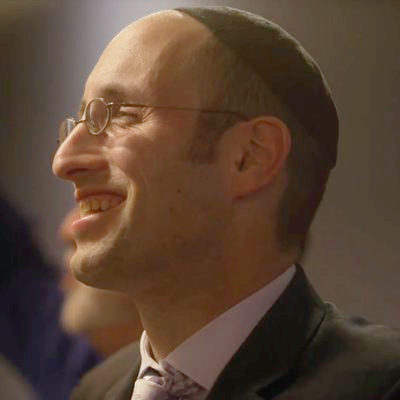Look On Our Works, Ye Mighty
How Percy Bysshe Shelley's “Ozymandias” is an oddly perfect Hanukkah poem.

Two centuries ago, Percy Bysshe Shelley challenged his friend Horace Smith to a 19th-century version of a poetry slam. He had read of the acquisition by the British Museum of the torso of Pharaoh Rameses the Second, known in Greek as Ozymandias, and suggested that both he and Smith write poems about this new exhibit. What Shelley composed became one of the most famous poems in the English language, a reflection on finitude and the limits of power. It describes the bust of a tyrant on a pedestal bearing a proud proclamation:
“My name is Ozymandias, king of kings:
Look on my works, ye mighty, and despair!”
Nothing beside remains: round the decay
Of that colossal wreck, boundless and bare,
The lone and level sands stretch far away.
What is less well known is that after composing this poem, Shelley would come upon another Ozymandian image, one that would inspire him to consider in two brief works of prose the mysterious endurance of the Jewish people. In 1819, Shelley traveled to Italy and was suddenly inspired by his visit to the Arch of Titus in Rome, with its depiction of Jerusalem’s despoiling by the emperor Titus, embodied by the image of the menorah held aloft in a triumphant Roman parade. Soon after, and not long before he drowned on the Italian coast, he wrote down his thoughts, in two “orations,” about the Jewish people. The Shelley scholar Nora Crook notes that there is “nothing quite like them in Shelley’s oeuvre,” as both are compositions “in which Shelley speaks in the person of an imagined contemporary Jew to fellow Jews.”
The first fragment imagines a 19th-century Jew standing at the Arch of Titus, staring at “the desolation of a city.” The Jew describes himself studying the Roman “procession of the victors, bearing in their profane hands the holy candlesticks and the tables of shewbread, and the sacred instruments of the eternal worship of the Jews.” On the opposite panel, he sees the emperor, “crowned with laurel, and surrounded by the tumultuous numbers of his triumphant army.” Titus, in other words, demands that all in his empire look upon his works and despair. Yet studying the destroyed colosseum nearby, the Jew is struck by a realization:
The arch is now mouldering into ruins, and the imagery almost erased by the lapse of fifty generations. Beyond this obscure monument of Hebrew desolation, is seen the tomb of the Destroyer’s family, now a mountain of ruins. The Flavian amphitheater has become a habitation for owls and dragons. The power, of whose possession it was once the type, and of whose departure it is now the emblem, is become a dream and a memory…
Or to put it differently, when it came to the Roman Empire, “nothing beside remains.”
The same, of course, could not be said for Jewish civilization. The menorah borne aloft to Rome ultimately disappeared when the city was sacked by the Vandals, but it was remembered in lamps relit in Jewish homes throughout the centuries, as it will be this and every year at Hanukkah. And if Jews chose to remember the story of one small flask of oil that somehow endured, it was because they view that tiny miracle as a metaphor for their own national life. Shelley’s Ozymandias is a story not only of Egypt, but of nation after nation throughout history—except one.
And Shelley, who, as Crook notes, was often Voltairian in his attacks on traditional faith, nevertheless seemed to understand this, as he pondered not only the Jewish past but also its future. The second Shelley fragment, also written in Rome, sits today in the University of Tokyo archive; according to the university website, it is “the only known manuscript in the hand of Percy Bysshe Shelley outside the UK, Europe, and the U.S., apart from a few letters. It came to Japan in the latter part of the Meiji era, when Japanese literary scholars were discovering the Romantic Poets and ‘Japonism’ in the West was at its zenith.”
In this second fragment, Shelley, again writing in the voice of a Jew, describes what he calls an “infallible plan,” and an unusual one for 1820: the re-attaining of what he calls the “land of promise” through “re-establishing the antient [sic] free republic of the Jews according to the Mosaic law, and rebuilding the City and the Temple.” Shelley, the website further notes, “does not portray Jews as helplessly mourning their lost land, unlike Byron in ‘Hebrew Melodies’ (1815), nor does he present the restoration of the Jewish nation as something for Western nations or Christian sects to take the initiative in promoting. Rather, it is something for Jews to achieve by their own efforts.” The author of “Ozymandias,” in other words, was led by his encounter at the arch, and the logic of his poem, to ponder the possibility of the return of the Jews to the Land of Israel 70 years before Herzl.
In December 2018, a gaffe was committed by the Catholic News Service when it attempted to tweet out an encouraging Hanukkah message. Seeking an online image of a menorah, it tweeted an image of the arch, joining this famous visual of the destruction of Jerusalem with the cheerful message “Happy Hanukkah to those who celebrate!” The News Service immediately apologized, and the tweet was an error, but it nevertheless unintentionally reflected a profound truth: The arch does indeed remind us of what we celebrate on Hanukkah, and how the celebration of Hanukkah throughout the centuries predicted the miracles of our own age.
“Ozymandias” is, therefore, an oddly perfect Hanukkah poem, in that the holiday celebrates the ultimate victory of the Jews over ancient foes when it comes to time itself—and it can be paired with another. Horace Smith, in his competition with Shelley, wrote a poem about Rameses that, in the face of his friend’s masterpiece, has been forgotten. But it, too, is worth remembering and reciting. Looking at a remnant of an ancient empire and acknowledging how all that was the Egyptian Empire is now gone, Smith put his pen to pondering what that meant for the future of the British Empire, which was, when he lived, the Egypt of its age. Smith reflected:
We wonder,—and some Hunter may express
Wonder like ours, when thro’ the wilderness
Where London stood, holding the Wolf in chace,
He meets some fragment huge, and stops to guess
What powerful but unrecorded race
Once dwelt in that annihilated place.
Nothing beside remains. But one nation endures.
This essay was originally published in Commentary.
How Percy Bysshe Shelley's “Ozymandias” is an oddly perfect Hanukkah poem.
How Percy Bysshe Shelley's “Ozymandias” is an oddly perfect Hanukkah poem.

